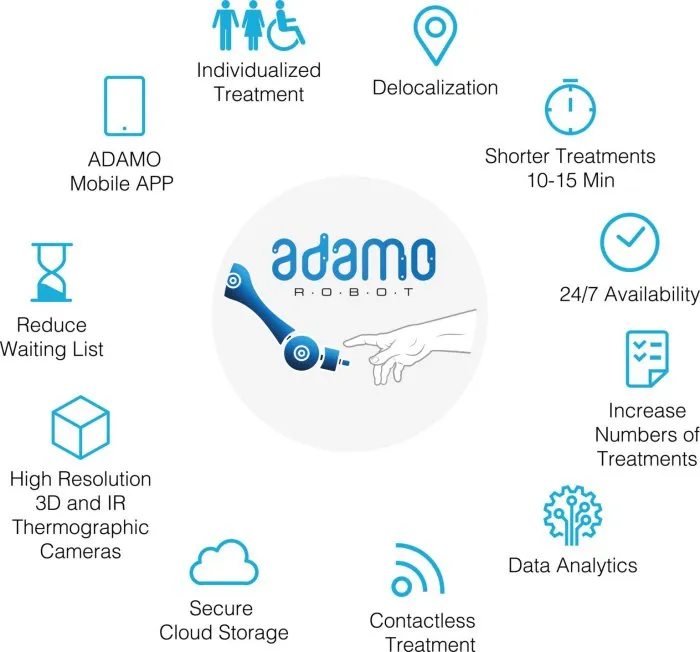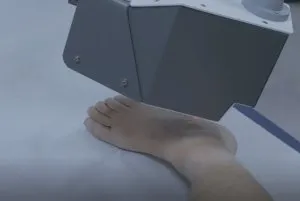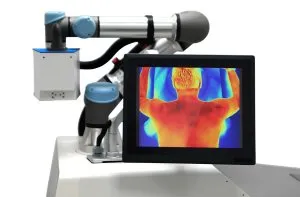
- Home
- Companies
- Adamo Robot
- Products
- ADAMO - Robotic Medical Device

ADAMO - Robotic Medical Device
The world’s first collaborative robot that treats MSDs with compressed air. For Rehabilitation Centers and Hospitals – Clinics or Sport Clubs. ADAMO is a robotic medical device capable of aiding in the diagnosis of back pain injuries and delivering contactless treatment using temperature-controlled pressurized air. ADAMO can help reduce patient recovery times, waiting lists, and treatment costs.
Painless treatments
All the treated patients report feeling no pain whatsoever during the treatment using the Visual Analog Scale.
Scientifically proven efficacy
According to the clinical trials conducted by La Rioja Centre of Biomedical Research (CIBIR), treatments with Adamo are at least as effective as manual treatments.
Custom proprietary softwate
Constantly updated software for the best user experience. User friendly and visual interface for maximum ease of use.
Contactless
Eliminate risk of cross-contamination between patients. Ideal for pathologies in which the therapist can’t contact the oatient’s skin.
Thermographic technology
Adamo comes equiped with a high resolution thermal camera. The resulting thermal images can aid :herapis:s in the diagnosis process and measure the evolution of the patients.
Improves treatment efficiency
Adamo treatments are shorter and contribute to shorten revovery times for patients, maximizing the number of patients treated and reducing waiting lists.

Musculoskeletal disorders (MSDs) are leading cause of disability worldwide, with prevalence of 1.3 billion, and responsible for 136 million of years lived with disability in 2017. Even though the incidence of MSDs increases with age, adolescents and people in working age group are also highly affected, leading to increased morbidity and even early retirement from work. Moreover, 60% of work-related health problems are caused by MSDs. These create a burden for the healthcare system with an estimated cost of €196 billion a year.
Adamo Robot is a collaborative robot, 100% safe, capable of treating musculoskeletal disorders applying a jet of pressurized air with a correct temperature and without the need for direct contact with the patient. The continuous pressure applied by the air jet imitates manual therapy techniques used by physical therapists for connective tissue, such as myofascial trigger point treatment, while also increasing the subdermal blood flow and oxygenation of the area.

Using Adamo makes it possible to automate tedious and repetitive tasks, increasing the productivity of physiotherapists, who will be able to treat more patients in less time, shorten waiting lists and, thanks to thermography, obtain objective data on the evolution of patients.
Finally, and most importantly, ADAMO can improve the wellbeing of the patients. Those who have tried it report improvements after just a few sessions of painless treatment.
ADAMO Robot offers the physiotherapist the possibility of applying the combination of sustained pressure, or massage sweeps, without contact, together with the physiological effects produced by thermotherapy, becoming a support tool that will enhance the recovery of their patients. The physiological effects produced by the robot’s functionalities are already scientifically proven to be successful in recovering from injuries.
Pressure and massage have been studied for multiple pathologies, musculoskeletal, cancer, fibromyalgia, etc. Likewise, due to the different transport speeds between the fibers that conduct pain (C and Aδ fibers) and the fibers that conduct pressure (Aß), the activation of spinal interneurons can be provoked and block the transmission of nociceptive stimuli to higher nerve centers.
The control gate theory is based on the same principle; block pain by pressing the surface and control the neurological mechanism. In addition, the pressure generated by compressed air at skin level can block the release of allogeneic substances (substance P, bradykinin, histamine) and prevent the activation of various ion channels in nociceptive fibers that generate pain.
Thermotherapy, the use of cold reduces pain, blood flow, edema, inflammation, muscle spasms and metabolic demand. Physiological effects of heat therapy include pain relief and increased blood flow, metabolism, and elasticity of connective tissues.

Adamo Robot is equipped with FLIR thermal cameras capable of accurately measuring the skins temperature. By measuring the thermal asymmetry of the patient’s body, Adamo Robot provides insights on their condition to aid the therapist in reaching the correct diagnosis so Adamo Robot can apply the most effective treatment. In addition, Adamo Robot can use the images taken before each session and compare them with each other to effectively measure the evolution of the patient’s condition and the progress towards total recovery.
Diagnostic
The diagnostic capabilities focus on the provision of information to facilitate a primary diagnosis of the pathology and serves as a support tool for monitoring the pathology.
It has been observed that asymmetric temperature differences that involve a difference of around 0.3 and 0.6ºC between one side and the other are indicative of pathology. Making these differences visually relevant to the physiotherapist can help them generate a better diagnosis and even rethink and adapt treatments based on the thermal evolution of the pathology. Let’s not forget that the robot can heat or cool an area. There are two approaches to thermographic imaging:
Static
Where the patient must comply with study conditions that do not influence the temperature of the area to be studied. This type of study will provide valuable information on thermal asymmetries or evolution in an inflammation, for example, or in a radiculopathy where the temperature will be decreased but may be limited in order to give an interpretation to certain musculoskeletal pathologies that have variable non-thermal. In this sense, the proposal of ADAMO Robot is the growth towards Deep learning and the treatment of Big Data, in order to provide information to the therapist based on the experience of the data.
Dynamic
Thermography is used to check how much and how quickly a muscle becomes vascularized, and therefore heated, after a demand for physical activity. This will allow the therapist to know before an injury, or in its evolution, to propose the most appropriate treatment based on said information.

The sensory receptors are located in the deep layers of the skin and are mainly the Pacini corpuscles (which respond to vibratory stimuli and mechanical pressure) and the Ruffini corpuscles (responsible for receiving temperature changes and recording the stretching). Both are connected to thick Aß-type nerve fibers, which are the ones with the highest conduction speed (Zimmerman et al., 2014). The fibers that transmit nociceptive stimuli (fibers Aδ and C, also known as pain fibers) have a lower conduction speed.
These nerve fibers mostly do not join at the dorsal gray horn but continue through the back of the spinal cord to reach higher nerve centers. But these paths that convey information from mechanoreceptors, emit a lateral root in the dorsal grey horn where the synapse with spinal interneurons takes place. These interneurons can contact second order neurons which are responsible for transmitting nociceptive information.

Due to the different transport speeds between the pain-conducting fibers (C-fibers and Aδ) and the pressure-conducting fibers (Aß), the activation of the spinal interneurons can be caused and the transmission of nociceptive stimuli to the higher nerve centers can be blocked (Zimmerman et al., 2014).
The control gate theory is based on the same principle, blocking pain by pressing on the surface and controlling the neurological mechanism (Guo & Hu, 2014).
In addition, the pressure generated by compressed air at the skin level can cause a blockage in the release of allogeneic substances (substance P, bradykinin, histamine) (Schmelz, 2011) and prevent the activation of various ion channels in the nociceptive fibers that generate pain (Caterina & Pang, 2016)
